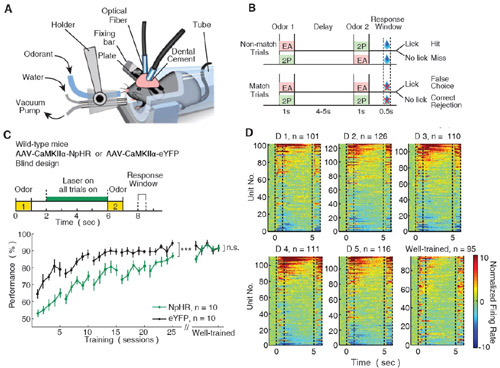Time:2014-10-27
A recent study published on Science demonstrated that the delay period activity in medial prefrontal cortex is critical for learning a working memory task. This work was performed by the researchers in Dr. LI Chengyu’s lab in the Institute of Neuroscience, Shanghai Institute of Biological Science, Chinese Academy of Sciences.
Working memory (WM) is essential for cognition by allowing active retention of behaviorally relevant information over a short duration known as the delay period. For example, when one is attempting to multiply 43 by 27 mentally without a calculator, the products of successive pairs of numbers need to be remembered temporally within a short period (of several seconds) and the products need to be added together mentally, resulting in the correct solution. During the short delay period, the brain has to hold the necessary information in working memory to guide cognitive behavior, in this case, mental calculation.
Previous studies have shown that the prefrontal cortex (PFC) is crucial for working memory. However, the functional role of PFC delay-period activity in working memory remains unclear. One important reason is that traditional methods, such as transcranial magnetic stimulation and electrical stimulation, do not provide the needed temporal resolution for perturbing neural activity, nor cell-type specificity. The other is that many traditional tasks used in working memory studies, such as delay-response task or delayed alternation, do not permit temporal separation of functional roles such as memory retention and decision making.
Dr. LI Chengyu’s group addressed this question by training mice to learn a working memory task with temporal separation of memory retention and decision making (Fig A, B). For each trial during training, an olfactory stimulus was presented as the sample, followed by a delay period and then a testing olfactory stimulus, either match or non-match to the sample. Water-restricted mice were rewarded with water if they licked within a response time window in the non-match but not match trials. During the delay period, mice need to retain the information associated with the odor sample. Decision making behavior cannot occur before the end of delay period and the second odor delivery.
They then used optogenetic method to suppress or enhance the activity of pyramidal neurons in mouse mPFC specifically during the delay period. Behavioral performance was impaired during learning but not after the mice were well trained (Fig C). This is a surprising result, as the majority of previous studies suggested that perturbation of mPFC activity in well-trained rodents impaired working memory performance. They further suppressed mPFC activity during the period of decision making and found that working memory performance was impaired in the later phase of learning, a result opposite to manipulation in delay period. Therefore optogenetic manipulation with temporal resolution of seconds revealed interesting temporal specificity in the contribution of mPFC activity to working memory behavior in different phases of learning.
To examine the neural correlates throughout learning of the WM task, Dr. LI Chengyu’s group recorded single-unit activity of mPFC by using tetrodes. The delay-period activity was more prominently modulated during the learning rather than the well trained phase (Fig D). Visualizing the population activity by principal component analysis, they found that activity trajectories during the delay period after two different odor samples were separated during the learning but not the well-trained phase. This indicates during learning, the delay activity may encode working memory. In further analysis, they found that the delay-period odor selectivity of neurons was correlated with the behavioral performance of mice.
These findings demonstrate the important contribution of mPFC delay activity in learning of a working memory task, which is helpful to reveal brain mechanism for working memory. The results also indicate that there are other brain regions mediating memory retention after task was well learned.
This work entitled “Medial prefrontal activity during delay period contributes to learning of a working memory task” was published in Science on October 24, 2014. LIU Ding, GU Xiaowei, and ZHU Jia are the first authors with equal contribution. The work was supported by Chinese 973 Program (2011CBA00406), the State Key Laboratory of Neuroscience .

Figure. (A, B) Behavioral diagram. (C) Behavioral performance and optogenetic experiment results. Each dot represents the performance correct rate of 20 trials (or 1 session). Performance = (Hit + Correct rejection) / total number of trials. For each day, mice performed 100 trials. (D) Modulation of population activity, which was normalized in Z-score and averaged across all trials for each neuron. 1~5s is the delay period. D, day.
 附件下载:
附件下载: